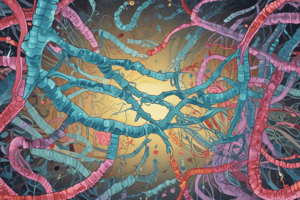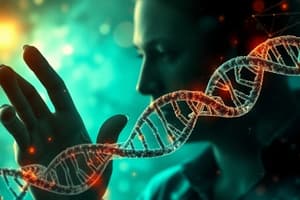Podcast
Questions and Answers
Which purines are found in both DNA and RNA?
Which purines are found in both DNA and RNA?
- Adenine and Uracil
- Cytosine and Thymine
- Guanine and Thymine
- Adenine and Guanine (correct)
What distinguishes RNA from DNA in terms of nitrogenous bases?
What distinguishes RNA from DNA in terms of nitrogenous bases?
- RNA contains cytosine and thymine
- RNA contains uracil and thymine
- RNA contains uracil instead of thymine (correct)
- RNA does not contain guanine
What type of bond links nucleotide monomers together in nucleic acids?
What type of bond links nucleotide monomers together in nucleic acids?
- Covalent bonds (correct)
- Peptide bonds
- Ionic bonds
- Hydrogen bonds
What is formed when the 3′ end of one nucleotide reacts with the 5′ end of another nucleotide?
What is formed when the 3′ end of one nucleotide reacts with the 5′ end of another nucleotide?
What is the basis for DNA synthesis and RNA synthesis?
What is the basis for DNA synthesis and RNA synthesis?
What is the main difference between asexual and sexual reproduction?
What is the main difference between asexual and sexual reproduction?
What is the primary form of DNA organization in prokaryotic cells?
What is the primary form of DNA organization in prokaryotic cells?
Which type of RNA is produced during the transcription of protein-coding genes?
Which type of RNA is produced during the transcription of protein-coding genes?
What distinguishes deoxyribonucleotides from ribonucleotides?
What distinguishes deoxyribonucleotides from ribonucleotides?
What is the main function of noncoding DNA?
What is the main function of noncoding DNA?
Study Notes
DNA Transfer and Reproduction
- DNA is passed from one generation to the next through both asexual and sexual reproduction.
- Asexual reproduction involves one parent organism producing genetically identical offspring.
- Sexual reproduction involves two parent organisms contributing genetic material, resulting in genetically unique offspring.
DNA Structure in Prokaryotic vs Eukaryotic Cells
- Prokaryotic cells typically have DNA as a single circular chromosome.
- Eukaryotic cells contain DNA organized into several distinct linear chromosomes.
- Each chromosome consists of both coding DNA (genes) and noncoding DNA.
Functions of Coding and Noncoding DNA
- Coding DNA includes genes that provide instructions for producing proteins and other essential molecules, such as tRNA.
- Transcription converts DNA information in genes to ribonucleic acid (RNA).
- Messenger RNA (mRNA) is transcribed from protein-coding genes, processes, and exits the nucleus to enter the cytosol.
- Ribosomes translate mRNA into proteins.
Noncoding DNA and Its Roles
- Noncoding DNA makes up the majority of the human genome and does not code for proteins.
- Some noncoding regions maintain chromosomal integrity (e.g., telomeres) or regulate gene expression.
Composition of DNA and RNA
- Both DNA and RNA are composed of nucleotides, classified as deoxyribonucleotides (DNA) and ribonucleotides (RNA).
- Each nucleotide comprises a sugar, a nitrogenous base, and one to three phosphate groups.
- The sugar in DNA is deoxyribose, while RNA contains ribose.
Structure of Nucleotides
- Carbon atoms in the sugar are numbered from 1' to 5'.
- A negatively charged phosphate group is attached to the 5' carbon and a hydroxyl (OH) group to the 3' carbon.
- A nitrogenous base attaches to the 1' carbon of the sugar.
- Nitrogenous bases include purines (two ring structures) like adenine (A) and guanine (G), and pyrimidines (one ring), like cytosine (C), thymine (T) in DNA, and uracil (U) in RNA.
Nucleotide Linkage and Polymer Formation
- Nucleotides link through covalent bonds between the 3' end of one and the 5' end of another, forming dinucleotides and longer chains.
- This progression continues to form long nucleic acid polymers consisting of thousands of nucleotides linked by a sugar-phosphate backbone.
- The linking mechanism is fundamental to DNA replication and RNA transcription.
Studying That Suits You
Use AI to generate personalized quizzes and flashcards to suit your learning preferences.
Description
This quiz covers the mechanisms of DNA transfer through generations, highlighting the differences between asexual and sexual reproduction. Students will explore how DNA is organized in prokaryotic versus eukaryotic cells, focusing on the structural complexities of chromosomes.




